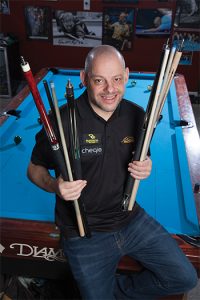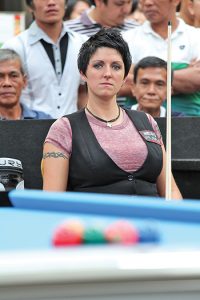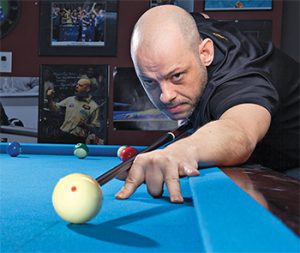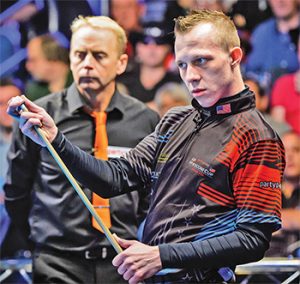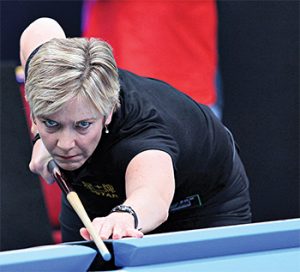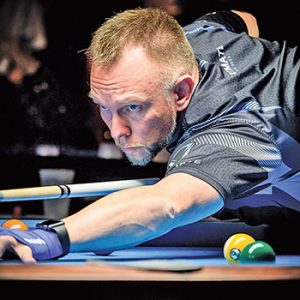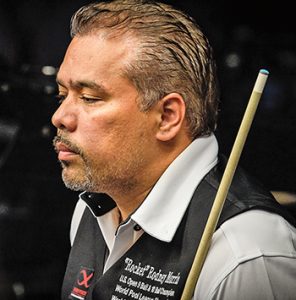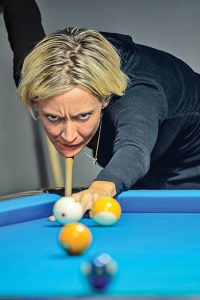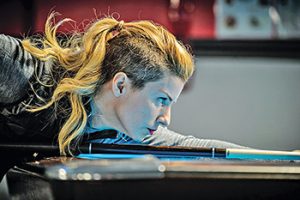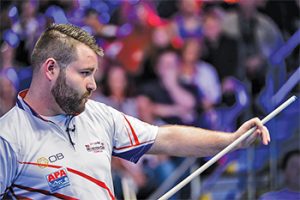The Big Time
It’s been 10 years since the International Pool Tour died. How will history judge the short-lived $13 million venture that showed the promise and peril of attempting to bring pool into the big time?
By Nick Leider
It almost seems like a fever dream, now that it’s been a decade since its death. The International Pool Tour, founded and funded by infomercial maven Kevin Trudeau, held four events in 14 months that awarded more than $6 million in prizes. Pool had not seen — and most likely will not see — anything like this in the history of the sport.
Efren Reyes, winner of two tournaments, pocketed $765,000. The matches were live broadcast across Europe in primetime. Players were told of guaranteed income in the six figures.
But now, 10 years after the IPT’s final event, the World Open, left players with little more than IOUs for $3 million, Billiards Digest revisits the IPT’s unbelievable rise and equally astonishing fall. While setting the record straight on what remains one of the most controversial eras in modern pool, one question begs for an answer:
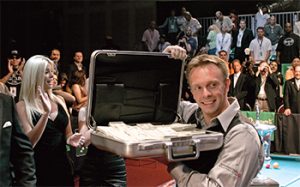
Though short-lived, the IPT still showered pros like Thorsten Hohmann with briefcases full of cash.
What was the IPT’s lasting effect on the game we love?
The Facts
Before telling the story of the IPT, it’s imperative to present the facts that are often lost in the legend of the IPT.
First, every player who won money received what they were due. The $3 million in prizes from the World Open, the abbreviated tour’s last stop, were awarded, though it took 14 months and a series of installments to meet the tour’s obligations.
Second, players did lose $2,000 paid to play in qualifying events for a tournament that never happened. The IPT postponed and then cancelled its future events, leaving those who had ponied up that qualifier money without recourse.
“Some players received that money back and others did not,” said Deno Andrews, the IPT tour director who handled day-to-day operations. “I can’t remember how many ended up losing that money. It was not that many players — with that said, any [number] more than zero was too large.”
Finally, among the top players who competed on IPT, the consensus was that, despite the missteps, broken promises and eventual failure, it was a good thing while it lasted.
“My brothers on tour, we were all really happy about Trudeau and the IPT,” said Rodney Morris, who earned $150,000 with a runner-up finish at that maligned World Open. “We made some money and we had a great time. We were more than happy to be a part of it. We wished things would’ve worked out, but I have nothing against anyone.”
Thorsten Hohmann, who netted $350,000 by winning the North American Open, agrees.
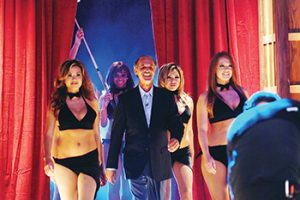
Trudeau’s events were lavish affairs, brimming with pomp and circumstance, as showcased in the Battle of the Sexes match between Loree Jon Hasson and Mike Sigel.
Still, the IPT, coming on so strong and crashing so quickly, affected much more than players’ bank accounts. To see these impacts, it’s worth starting at the beginning.
The First Time
The World Championship Open (Aug. 20, 2005)
Trudeau’s entry into professional sports was a moment of serendipity for pool, a bit of luck for a sport that desperately needed it. The women’s game, buoyed largely by the WPBA Classic Tour, was in decent shape, with events regularly appearing on ESPN and top players able to support themselves with tournament winnings. The men’s side, though, had little as far as organization. The Professional Billiards Tour Association had collapsed in the decade prior. Outside of a few big world championship tilts and the annual U.S. Open 9-Ball Championship, organization was minimal and cooperation was almost nonexistent.
The seeds of the IPT, though, were planted a decade earlier in 1994. Trudeau was already a successful businessman, but he was not yet riding what would be a wave of commercial success based largely on his “Natural Cures” brand, including a New York Times bestselling book and ubiquitous late-night infomercials. Long a fan of pool, he caught a radio advertisement for an exhibition in the Chicago area featuring Hall of Famer Mike Sigel.
“Kevin got in touch with me saying he wanted personal lessons,” Sigel said. “We became friends and I would see him every few weeks. And then I got it in my mind. I said, ‘Hey, you got all this money and you love pool. Let’s do something for the game.’
“I nagged him for 10 years, saying we should do something together. Finally, one day when we were playing pool, he said, ‘Let’s do it.’”
The two scribbled down some notes about prize money. Sigel imagined top prizes around $100,000, with other top finishers pocketing proportionally big bucks. Trudeau, though, had bigger ideas from the start.
“He looked at all that, without even adding it up,” Sigel said, “and he said it’s got to be bigger. For him, from the start, it wasn’t a matter of doing something. It was a matter of how big it was going to be.”
Eventually, the plan was to hold a kickoff challenge match in August 2005 between Sigel and fellow Hall of Famer Loree Jon Jones in Las Vegas. Dubbed the World 8-Ball Championship, the battle of the sexes paid the winner $150,000 with a consolation prize of $75,000. Trudeau threw a lavish party the night before the event, replete with celebrities. On the day of the Sigel-Jones match, the celebrities (actors Paul Sorvino, Allison Janney and Anthony Anderson, rapper DMX and boxing legend Thomas Hearns among them) entered the arena in true red carpet style.
Deno Andrews was taken with Trudeau’s insistence on this being like nothing pool had seen before.
“Everything had to be big. We did nothing half-assed,” Andrews said. “What gets him going is entirely different than what gets the rest of us out of bed. He wanted it big and he wanted it immediately.”
By August, the IPT had crash-landed on the pool world.
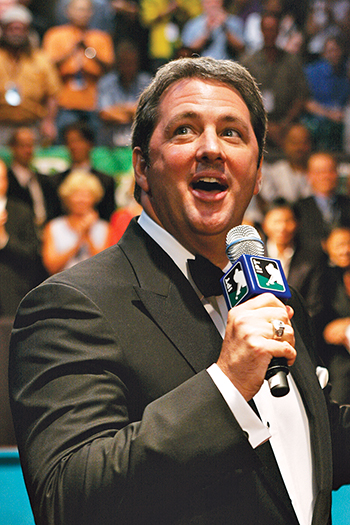
With media maven Trudeau at the helm, “everything had to be big.”
If a guy wanted to get pool players’ attention, big money and bright lights aren’t the worst ways to do so.
The Best of Times
The King of the Hill 8-Ball Shootout (Nov. 30-Dec.4, 2005)
The North American 8-Ball Championship (July 22-30, 2006)
The IPT initially started with 150 players hand selected by Trudeau and the IPT brass. Potential tour members had to apply for a spot on this lucky list, which may be the first and only time pool players put together resumes en masse.
A group of players automatically qualified based on past performance. Think Johnny Archer, Efren Reyes, Rodney Morris and other world-class talents. A dozen living Billiard Congress of America Hall of Famers received automatic entry and a $30,000 bonus simply for being part of the tour. Other players had to apply to tour membership. Darren Appleton, then a professional English 8-ball player but largely unknown in the U.S., emailed his application to the tour hoping that his unmatched record in a slightly different discipline would earn him a spot. (It did.)
The King of the Hill event, however, would only see 42 players compete for the $1 million prize fund, with $200,000 going to the winner. Still, the IPT managed to get all 150 players to Orlando for the event, because a mandatory players meeting promised to detail just what the tour had in store for its first year.
“It was the greatest speech I’ve ever heard,” said Thorsten Hohmann, of Trudeau’s pitch to the players. “It was incredible. I wasn’t really too aware of everything until I got to Orlando and heard Kevin. That made me realize: Holy shit. This is something big.”
Appleton, whose involvement with the tour led to him ditching English 8-ball for the American variety, was equally blown away.
“That players meeting, [there] was amazing excitement. I felt like a professional sportsman,” he said. “This was the biggest thing to happen for pool.”
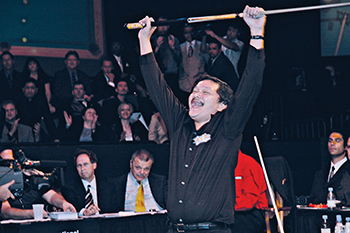
Reyes scored pool’s biggest ever prize.
Six months later, the North American Open brought 200 players to the Venetian in Las Vegas for a chance at the $2 million purse. The top prize was $350,000, the biggest single payday in the history of pool. EuroSport was broadcasting the event live in primetime. Deals were made with Outdoor Living Network to replay the matches for North American audiences. Before a ball was struck, this event was the most significant tournament in years.
The grueling round-robin, multi-round format had players playing four or five race-to-8 sets a day, often clocking more than 12 hours at the table. Hohmann eventually prevailed over Filipino snooker convert Marlon Manalo. But what happened on the table took a backseat to the event itself. The bright lights, the professional production, the class of such an event seemed to mark pool’s arrival as a legitimate sport.
But just two months later, at the IPT’s fourth event, the wheels fell off what everyone thought was pool’s gravy train.
The Worst of Times
The World 8-Ball Championship (Sept. 3-9, 2006)
The World 8-Ball Championship began with Trudeau announcing the cancellation of a scheduled event in London, which had some of the 200 players nervous about what was to come. Regardless, the $3 million prize fund went a long way to relieving any anxiety among the players.
The grueling tournament schedule, again having players compete nearly nonstop for days at a time, left Rodney Morris facing Efren Reyes for the $500,000 top prize. The on-table action ended with the Filipino legend pocketing the top prize while Morris “settled” for $150,000.
Or so it seemed.
All the players left the Grand Sierra Resort and Casino in Reno, Nev., with nothing. Players walked away with promises of future payments, but concerns that were raised at the players meeting became very real for those with a stake in the game.
“That Sunday, Kevin came to me and said the money wasn’t in the bank,” Andrews said. “I’ll never defend him not paying the players. That was wrong and it will go down in history as wrong. But I told him, 100 percent, he needs to pay the players and he said he would.”
Rumors circulated about a proposed deal with Stanley Ho, a billionaire casino magnate based in Hong Kong, to buy the tour. The supposed windfall from this would have supported the tour’s future, Trudeau insisted. But an agreement never materialized. Also, on Oct. 13, 2006, President George W. Bush signed into law the Unlawful Internet Gambling Enforcement Act, which outlawed wagering over the Internet for individuals in the U.S. This, according to the IPT, impacted the tour’s ability to market itself to potential buyers.
Over the course of 14 months, in nine installments of 11 percent, the payments arrived. All the while, no further tournaments were scheduled. The IPT staff, once more than 20 people, was slashed to a skeleton crew of five. Unable to produce profits through events, Andrews pivoted to reducing costs and raising what revenue he could through streaming recorded matches online, selling DVDs and collecting TV and product royalties.
The money wasn’t flooding in, but it was substantial enough to cover roughly half the amount owed to players, according to Andrews, with Trudeau covering the remainder.
“He could’ve filed for bankruptcy,” Andrews said. “He could’ve stiffed the players, but two months after that tournament, I did everything I could to persuade him to commit to paying the players.”
While the payments trickled out, the IPT held seven challenge matches, one-on-one events that were streamed online. The response was tepid and a steep decline from the glitz and glamor of the major tournaments that preceded them. The tour continued on in a sense, but it was evident to everyone within the sport that the IPT of 2007 was a far cry from what the tour had been just months before.
With the future of the IPT falling well short of expectations, Sigel took issue with players who quickly lost faith in the IPT.
“When players started knocking [Trudeau], I couldn’t believe it. That has to leave a bad taste in your mouth,” he said. “That’s when I thought, if it was me, I wouldn’t pay them and just go bankrupt. But he paid him. That’s the kind of guy he was.”
Andrews, however, puts blame on those around the game.
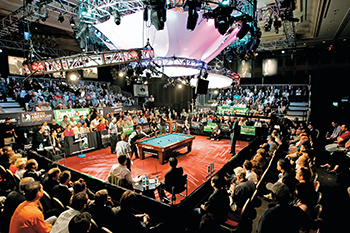
No expense was spared in the production of IPT events, including a sparkling arena to dazzle the masses.
Regardless of where blame lies, those who had the most to gain from the IPT adventure felt a real sense of loss once it was clear things weren’t going to turn out as advertised.
“I had a chance to win $500,000 and then I had to go try to win $10,000?” Morris said. “I lost a lot of motivation. I did a lot of soul searching at that time. For about a year there, I didn’t know what I was going to do. I was depressed for a while.
“It was real hard. I didn’t want to play at all. For a year, I was in a coma. I could’ve been on the “Walking Dead” — just walking around without an idea.”
Hohmann, another player who had profited immensely from the IPT’s short run, expressed similar feelings.
“It wasn’t like the tour ended at once,” he said. “It was a bit of a slow death — them dragging it out with exhibition matches. Of course I fell into a slump … It took me a few years to recover from that. You have these high expectations and then you’re back to playing in tournaments where you’re walking away with $2,000. It was hard.”
The End of Times
Once the players had been paid in full, Andrews met with Trudeau to discuss the IPT. More than $13 million had been invested, including prize money, production costs and marketing. The operation, already stripped to its bare minimum, was barely paying for itself.
The IPT, as it had been packaged from the beginning, was all but dead and buried. At that point, pool’s golden goose decided to pull the plug.
The slow death, as Hohmann put it, had come. But now, in 2016 and a decade after the cash was stacked on the pool table at the first event, the question still remains: Was the IPT a net positive or negative for pool?
“It was good,” Sigel said. “To this day, I defend the IPT whenever I hear someone talk about it. Add up all the money in the years before and after and it won’t come close to the $13 million Kevin put into the game.”
Sigel, who first hatched the concept of the IPT, agrees with Andrews, who was involved in the execution of that idea.
“Ultimately, it was good,” Andrews said. “If you remember what it was like before the IPT, it was very similar to what it is now. It was exactly like it is today … We created an entirely alternate universe for pool. It happened in a vacuum and ultimately I don’t think it had much of an effect on pool. It didn’t impact the actual state of the sport today.”
“He invested an amazing amount of money and it was great,” Appleton said. “I started playing American pool because of the IPT. I have that time to thank for my career and everything I’ve achieved since then.”
“Pool players can be some of the most loyal, trusting and straightforward people,” Andrews said, who continued to work with Trudeau until 2013. “Really the promoters are goofier than the players. The players show up, they pay their expenses, they pay the entry fees, they practice. They do all this stuff, and it’s such a basic thing: Pay them on time.
“I still hear about this. The money isn’t there or the added money was different than what was published … We were as guilty as anybody, but the players were overwhelmingly supportive.”
Teams Set For Mosconi Cup
With the announcement of the final “wildcard” selections by the opposing captains, the final rosters for Team USA and Team Europe are set with four weeks to go before the 23rd Mosconi Cup commences at the Alexandra Palace in London, Dec. 6-9.
Team USA captain Mark Wilson used his wildcard picks to add Mosconi Cup veteran and recent Billiard Congress of America Hall of Fame inductee “Rocket” Rodney Morris and 29-year-old Justin Bergman to the roster. It will mark the tenth Mosconi appearance for Morris and the third consecutive appearance by Bergman. The duo will join Shane Van Boening, Skyler Woodward and Mike Dechaine, who earned automatic spots on the team by finishing in the top three in points over 28 tournaments throughout the year. Only Morris did not play on the 2015 team that fell to Team Europe, 11-8, in Las Vegas. (Corey Deuel was the fifth member of Team USA in 2015.)
Team Europe captain Marcus Chamat handpicked reigning World 9-Ball Champion Albin Ouschan of Austria and England’s Darren Appleton, who will be making his eighth consecutive appearance, to join Holland’s Niels Feijen, Scotland’s Jayson Shaw and England’s Mark Gray. The three automatic berths on Team Europe were awarded to the points champion of the EuroTour (Feijen), the top European points earner on a World Events Rankings (Shaw), and the highest-ranked player on the Combined (Gray, who placed third behind already-qualified Shaw and Feijen). Feijen, Appleton and Ouschan also appeared for Team Europe in 2015.
As is customary, the wildcard announcements were greeted by second-guessing in social media. American fans questioned Wilson’s selection of Bergman, ranked sixth on the U.S. points list, over fifth-place finisher Oscar Dominguez. (Morris finished fourth in points.) Given the fact that the 2015 squad was made up of the top five point-earners, and the fact that Bergman lives in southern Illinois, not far from Wilson’s St. Louis home, charges of favoritism and “politics” were bandied about as fans weighed in. “I don’t have a bias and I don’t give those claims any credence,” said Wilson. “I simply picked the team that I thought gave us the best chance of winning this year. I analyze things like late-season performance, strengths and weaknesses and how they fit in with the strengths and weaknesses of the rest of the team.
“In the case of Rodney,” Wilson continued, “He went to the last six events. The effort and results were there. He gives us the best chance of winning.Last year it just happened that the team I chose finished one through five in points. That doesn’t mean that is the way it was meant to be. People seem to have a hard time with the concept of what the wildcard pick means.”
The concept of a “wildcard” selection was even more pronounced in Chamat’s selection of Appleton for Team Europe. While the former World 9-Ball Champion has been a member of six Mosconi Cup-winning squads, Appleton suffered through a subpar 2016, failing to crack the top 10 in the European Combined points list.
“No player really stood out for me for the last spot,” said Chamat. “There are so many good players in Europe, but I had to weigh the ups and downs. Darren is a big-match player with huge experience. And he is an awesome team player. I could have picked other players, but I believe in Darren. This is the biggest event for all of us and the pressure will be amazing. I think Darren will be amazing, too.”
‘Rocket’, ‘Belle’ Enter BCA Hall of Fame
For smooth-stroking lefty “Rocket” Rodney Morris, the call informing him of his election into the Greatest Player wing of the Billiard Congress of America Hall of Fame came as both a shock and a relief. “I want to cry,” Morris said after getting the news. “It’s validation and recognition of all the years and hard work I’ve put into this game. [It is] especially gratifying because I came from a broken home, was raised on the streets and made just about every mistake you can make. But I persevered, which proves that everyone can do something great if they dedicated themselves to it.”
Morris, 46, will be joined in the Hall of Fame by “The Texas Belle,” Belinda Calhoun, who was elected in the Veteran Players category. The United Billiard Media Association announced the results in a release, July 19.
Born in Anaheim, Calif., but raised in Hawaii, Morris scored his biggest win in 1996, topping the legendary Efren Reyes in the final of the U.S. Open 9-Ball Championships. The 26-year-old Morris still considers his title-match win the highlight of his illustrious career.
“Efren was at the top of his game,” Morris recalled. “When I used to practice, I always visualized playing Efren in my mind. That’s how I trained myself. Then, to beat him in the U.S. Open final was unbelievable. Now, to be able to say I’m in the Hall of Fame with him is even bigger.” Just when Morris was hitting his competitive stride, though, he was convicted on federal drug charges and spent nearly four years in jail. Remorseful and recommitted, Morris returned to the pro tour in 2001 and promptly won the Sands Regency Classic. Over the next six years, Morris added the UPA Pro Tour Championship, the World Pool League crown and the World Cup of Pool title. In 2006, Morris suffered his biggest heartbreak in competition, falling to Reyes in the final of the ill-fated International Pool Tour World 8-Ball Championship in Reno. Reyes earned $500,000 for the title, while Morris had to settle for $150,000.
“Efren was my biggest win, and my biggest loss!” Morris said. Morris also made eight appearances representing Team USA in the Mosconi Cup, earning MVP honors in 2004. Still active, Morris has added titles at the Turning Stone Classic and the U.S. Open 10-Ball Championships in recent years. Calhoun, 63, was born in Austin, Texas. As Belinda Campos, she became one of the Women’s Professional Billiards Associations biggest starts in the ’80s, winning a pair of BCA National 8-Ball Championships titles, the Texas River City Open crown and the NPCA Classic Cup. Calhoun was dominant in 1985, winning the Women’s World 14.1 title, the WPBA National 9-Ball Championship and the U.S. Open 9-Ball Championship. Calhoun’s big year earned her Billiards Digest Player of the Year honors.
“I had resolved myself to the idea that [getting into the BCA Hall of Fame] wasn’t going to happen,” said Calhoun, who had been moved into the Veteran Player category after failing to earn election in the Greatest Player category before turning 60. “This is a wonderful surprise. I’m honored. I had always thought my career was deserving.” In extremely tight voting, Morris edged WPBA champions Gerda Hofstatter and Vivian Villarreal by a single vote. Kim Davenport, Shannon Daulton and Jeremy Jones were also on the ballot.
Wilson Names Team USA Hopefuls
 As was his original intent, Mosconi Cup Team USA Captain Mark Wilson worked quickly to select the players who will compete for the final five roster spots for the 2014 event in December in Blackpool, England. Wilson announced the selection of eight players who will train and compete together through the summer, before the captain whittles the list down to the five players who will wear the red, white and blue in Blackpool.
As was his original intent, Mosconi Cup Team USA Captain Mark Wilson worked quickly to select the players who will compete for the final five roster spots for the 2014 event in December in Blackpool, England. Wilson announced the selection of eight players who will train and compete together through the summer, before the captain whittles the list down to the five players who will wear the red, white and blue in Blackpool.
Not surprisingly, Wilson tabbed America’s No. 1, Shane Van Boening, and immediately announced that he will expect the taciturn star to provide leadership to the 2014 squad. “Shane sets a great example,” Wilson said in a press release. “And I expect to rely on him for leadership this year.”
Wilson also named seven-time Mosconi Cup veteran Corey Deuel, who many thought should have been on the team in 2013, to the squad. John Schmidt, Oscar Dominguez and Brandon Shuff, each of whom has participated in one Mosconi Cup, were named to the team was well. Leaning on America’s youth, Wilson rounded out his selection with Southern Classic One-Pocket champion Justin Bergman, Derby City titlist Justin Hall and Connecticut’s Jeremy Sossei.
“I’m really excited by this team,” Wilson said. “Every player seems so genuinely appreciative and excited. They’re all willing to do whatever it takes to develop a strong team and a strong sense of unity.”
More interesting than who Wilson selected, of course, was the list of players who weren’t invited to “camp.” The most notable omission was Johnny Archer, whose string of 17 consecutive Mosconi Cup appearances will come to an end. Fourteen-time Cup participant Earl Strickland and nine-time team member Rodney Morris were also left off the roster. In fact, Van Boening will be the only holdover from the 2013 squad that lost 21-1 to Team Europe in Las Vegas.
“I didn’t interview those players,” Wilson admitted. “And I explained to Johnny that I thought it best to go in a completely different direction this year. A lot of it is about attitude. Last year I felt there was no sense of urgency. There seemed to be a sense that it was a yearend bonus, and if the team won, great.”
Another player conspicuous by his absence is Mike Dechaine, one of the most consistent American players over the past three years.
“I spoke to Mike,” said Wilson. “In the end I felt that his reputation among the players wasn’t a good fit at this stage for a team event like the Mosconi Cup.”
Wilson added that his plan is to get the players together several times over the summer and fall for practice and team bonding. Wilson said he planned to make the final cut to five players after the U.S. Open, and that Team USA would meet and practice together for a week at Lindenwood University near St. Louis before departing for London. The dates of the 2014 Mosconi Cup are Dec. 1-4.
You Guessed It: Filipinos Reign at First World Cup
The Filipino dream team of Efren Reyes and Francisco Bustamante became the inaugural PartyPoker.com World Cup of Pool champions as they blew away Team USA, 13-5, in front of a packed arena at the Newport Centre, South Wales.
The American duo of Earl Strickland and Rodney Morris were expected to make a match of it, but a combination of bad luck and loose shots on the part of the Americans and unrelenting skill from the Filipinos kept them at bay.
With upwards of 900 people in the arena including a large contingent of expatriate Filipinos, the atmosphere was electric and the tension mounted as the two teams shared the first eight racks of the race-to-13 final.
From there though things unraveled for the Americans. They lost control of the cue ball on the break and consequently found it difficult to get any momentum.
By contrast the Philippines turned up the heat with Reyes in particular playing a series of stunning shots to get out of jail and pot some seemingly impossible balls.
The second half of the match became something of a procession as the Philippines won seven consecutive racks to leave their opponents in no man’s land.
Team USA got one back to take the score to 11-5, but Reyes and Bustamante knocked off the final two racks to take the magnificent silver trophy, the title and a check for $60,000.
“It’s funny that every time there is a new big tournament, I win it, but all week I thought if we could get to the final we can win, said a delighted Efren Reyes after the match.
“The USA is a good team but they were unlucky and that made it easy for us,” he said.
Bustamante was thrilled to take pool’s first ever World Cup event. “In the beginning there was a lot of pressure on us but when we went three games ahead it all lifted,” he said.
“Efren played lots of unbelievable shots; some of them I’ve never seen in my life! That’s why we won.”
For the Americans, Rodney Morris summed up their feelings: “That was pretty disappointing. After 4-4 it didn’t go our way although the match was closer than the score suggested, but when it went to 7-4 we were both pretty deflated and felt it slipping away.”
“We never really got a clear shot off the break and it was a tough hill to climb but they played great – the way they were supposed to, so congratulations to them,” Morris added.
Thirty-one Countries Vie for World Dominance in Wales
National pride is at stake at the PartyPoker.com World Cup of Pool, taking place now at the Newport Centre in Newport, Wales. Pressure is high as the scotch doubles matches are played on a straight knock-out basis.
The first round began on Aug. 22, with 32 two-man teams working together to represent their country. Thailand, represented by Tepwin Arunnath and Amnuayporn Chotipong, fell to Canadians Luc Salvas and Tyler Edey, 9-5. Team Qatar (Fahad Mohammadi and Bashar Hussain) was stymied by Malaysians Patrick Ooi Fook Yuen and Ibrahim Bin Amir, 9-3. And in an inter-continental contest, the Czech Republic, represented by Roman Hybler and Michal Gavenciak, defeated Poland’s Radoslaw Babica and Mariusz Roter.
The Phillipines, represented by Efren Reyes and Francisco Bustamante, were the clear crowd favorites, and rose to the occasion in round one, with a 9-0 massacre over Malta’s Tony Drago and Alex Borg. It was a tight battle between Taiwan’s Wang Hung-hsiang and Yang Ching-shun and India’s Dharminder Lilly and Alok Kumar. The tiny island nation prevailed, 9-6.
England has two teams in the running, one of which is represented by Steve Davis and Daryl Peach. It was 5-5 before the Brits were able to pull ahead of Jeong Young-hwa and Lee Gun-jae of Team Korea. On Davis’ 49th birthday, he joyously accepted their 9-6 victory.
In the second day of play on Wednesday, Aug. 23, Russia’s Konstantin Stepanov and Konstantin Zolotilov starved Hungary’s Vilmos Foldes and Gabor Solymosi of opportunities, defeating them 9-3.
Hong Kong produced a heroic performance to stun sixth- seeded Sweden in the biggest shock thus far in the PartyPoker.com World Cup of Pool. Sweden, whose side consisted of former World Championship finalist Tom Storm and former World Championship semi-finalist Marcus Chamat, had been 4-1, 6-2, and 8-5 ahead in the race-to-9. But the Hong Kong pairing of Lee Chenman and Kong Man-Ho showed their character to win the last four racks to secure a place in the final 16.
Team Japan, Maasaki Tanaka and Satoshi Kawabata obliterated Indonesia’s Imran Ibrahim and Ricky Yang, 9-0. While the English “A” team of Ronnie O’Sullivan and Raj Hundal, didn’t have it quite so easy against Spain’s David Alcaide and Rafael Guzman. The crowd was gutted as the duo fell to a fast 4-0 deficit, but had their hopes back up as England got their nose in front at 8-7, but the Spaniards took the final two racks to close out a famous victory.
Team U.S.A. is composed of Rodney Morris and Earl Strickland, who had a decided victory over Singapore. The home team, Rob McKenna and Ben Davies of Wales, disappointed their fan base with a heart-breaking 9-2 loss to Germany (Thomas Engert and Oliver Ortmann).
Today, Aug. 24, three matches are left to determine the final 16. This morning, Ireland had no luck against Finland’s Mika Immonen and Markus Juva, heading home after a 9-5 loss.
The first matches of round two will begin tonight, with No. 1-ranked Phillipines and No. 3-ranked U.S.A. taking on their respective opponents. For up-to-the minute coverage at www.partypoker.com!
IPT Round Three Complete
LAS VEGAS, Nev. – Despite some strong opposition from European players, including the surprising contingent of English 8-ballers, the always tough Filipinos are dominating the history-making IPT North American 8-Ball Open.
Virtually every Filipino competitor who started in the 200-player field has made it through to the 36-man fourth round of play – nine altogether, including three Pinoy hopefuls who needed to win qualifiers to gain entry to the $2 million tournament.
Leading the pack, as usual, was legendary Efren “Bata” Reyes, whose overall record stood at 12-1 after three days of round-robin play. No less impressive was the ball-control mastery of Filipino Marlon Manalo, who held an identical 12-1 record, along with Germany’s Ralf Souquet and Rafael Martinez of Mexico.
Third-round play began on Wednesday at the Venetian Hotel and Casino with the remaining 60 players divied into 12 groups of five. The top three in each group would advance to the fourth round on Thursday with a guarantee of at least $17,000 in prize money; the eliminated players would collect a still-impressive $10,000 each.
By 9:45 p.m., the lucky 36 were known. Their names follow, grouped by country, with their third-round records:
USA: Dee Adkins, 4-0; Jason Kirkwood, 3-1; Earl Strickland, 3-1; Cory Deuel, 4-0; Shawn Putnam, 3-1; Rodney Morris, 3-1; Larry Nevel, 3-1; Gabe Owen, 2-2; and David Matlock, 2-2.
Philippines: Efren Reyes, 4-0; Marlon Manalo, 4-0; Francisco Bustamante, 2-2; Dennis Orcollo, 3-1; Antonio Lining, 4-0; Rodolfo Luat, 2-2; Alex Pagulayan, 3-1; Santos Sambajon, 2-2; and Ronato Alcano, 2-2.
United Kingdom: Rico Diks, 2-2; Raj Hundal, 1-3; Daryl Peach, 2-2; Darren Appleton, 2-2; Mick Hill, 3-1.
Netherlands: Niels Feijen, 3-1; Alex Lely, 3-1; and Nick Van den Berg, 3-1.
Germany: Ralf Souquet, 4-0; and Thorsten Hohmann, 3-1.
Other countries: Quinten Hann (Australia), 2-2; Ivica Putnik (Croatia), 2-2; Mika Immonen (Finland), 3-1; Sandor Tot (Italy), 2-2; Yannick Beaufils (France), 2-2; Rafael Martinez (Mexico), 4-0; Evgeny Stalev (Russia), 2-2; and Marcus Chamat (Sweden), 3-1.
Here are some highlights from the round:
* The biggest eye-opener for many established players at the Open has been the success of the top competitors on the English 8-ball circuit, including perennial champions Mick Hill and Darren Appleton. Both will compete in the round-of-36.
“Us lads have come to play the top players from around the world, and I feel that we haven’t been given a chance,” said 26-year-old Hill. “The point that us English lads want to get across to everyone, including our own back home, is that we’re playing 8-ball, not 9-ball or straight-pool. … A lot of people don’t realize that the English players play 8-ball.”
Among their strengths are excellent cue ball control and solid stroke mechanics, said observers.
“Those guys shoot very straight, and I can respect that,” said IPT member Ike Runnels.
* Fifteen women started the competition on Sunday, and only former snooker stars Allison Fisher and Karen Corr were given much of a chance to advance. One woman was able to infiltrate the third round, and she was a U.K. native, but no one you might expect.
“I sort of in a way proved a point,” said Sarah Ellerby, who collected dozens of 8-ball titles in England before coming to the U.S. to compete on the WPBA Classic Tour. “…There wasn’t as much attention on me as on the other girls, and that’s fine.
“I’m sure that some of the guys were like, ‘The women won’t do well here,’” Ellerby said. “If I could break better, I feel like I could really make more of a dent. I think the women are capable enough to come here and do well.”
Unfortunately, Ellerby fell into a tough bracket in the third round and finished with a 1-3 record. Knowing she wouldn’t advance, Ellerby immediately left for the Las Vegas airport to catch an 11:30 p.m. United Airlines flight to Chicago. There, she would catch a limo for a two-hour drive to Peoria, the site of the WPBA Midwest Classic, which was starting play Thursday morning.
“I’m going to be very tired,” she said.
* Staying on the English for another moment, sharp observers might note that Raj Hundal advanced with a 1-3 record. It’s no misprint. Hundal was in a bracket with players who posted 4-0 and 3-1 records (Reyes and Strickland), leaving the other three players with 1-3 tallies. Of the three, Hundal had the highest games-won percentage (56.49 percent, just over American Gary Abood’s 55.09 percent), which pushed him into the next round. That 1.4 percent difference was worth at least $7,000.
“I’m in! I’m in!” the burly Hundal screamed upon hearing the results. “I’m freewheeling tomorrow! … I’m the luckiest [expletive] in the world!”
* Another surprise at the end of the day was how many players who were forced to qualify for the event ended up in the round-of-36. The 200-player field offered 50 qualifiers, and no fewer than nine made it into the fourth round. They included Filipinos Luat, Sambajon and Alcano.
* Most of the favorites remained in the running for the fourth round, with one major exception. American Johnny Archer faded in his bracket, finishing with a 1-3 record.
Who Will Rule Pool?
The World Pool Masters are underway at the Hotel Zuiderduin in Egmond aan Zee, The Netherlands, with 16 male players vying for wold dominance in straight-knockout, single-elimination 9-ball.
Of the 16 players, nine are Europeans: Nick van den Berg, Alex Lely and Neils Feijen of Holland, Thomas Engert and Ralf Souquet of Germany, and Ronnie O’Sullivan, Steve Davis, Imran Majid and Raj Hundal of England. The remainder of the field was filled out by Wu Chia-ching of the Chinese Taipei, Hiroshi Takenaka of Japan, Efren Reyes and Alex Pagulayan of the Philippines and Rodney Morris as the lone American.
The first-round began today (June 16) and so far, defending champion Hundal eliminated Hiroshi Takenaka, 8-5, while Feijen sent Morris packing, 8-3. Feijin’s win will put him in the quarterfinal with Hundal on Saturday evening.
Morris, who reached the final of last year’s event, said: “I felt good but with the alternate-break format I couldn’t come back when I went down a couple of games.”
Meanwhile, Foldes nabbed a nail-biter match against van den Berg, 7-8. The back-and-forth match was at hill-hill when Foldes broke and ran out for the win, much to the dismay of the Dutch crowd.
“I’m delighted to have won. It was a very tough game and either of us could have won it but in the end I kept it together to clear that last rack for victory,” Foldes said afterwards.
Third Round Brings All-Star Match-ups at the Reno Open
The 2006 Reno Open is underway at the Sands Regency in Reno, Nev., yielding a field of 156 players.
Tournament coordinator Mick McMillin said that the number of players at the tournament, usually at or above the 200 mark, has decreased this year due to the International Pool Tour qualifiers.
Nonetheless, some great pool is being played. The third round brought about several marquis matches, including a match between longtime friends Gabe Owen and Jeremy Jones. Jones now has the upperhand, defeating his friend, 9-5.
Edwin Montal came up against Rodney Morris in the third round, besting him, 9-2, and Dennis Orcollo sent Cory Deuel to the one-loss side, 9-5.
Kim Davenport remains undefeated in the fourth round, and will match up against Filipino Jose Parica. Young Austin Murphy also remains on the winners’ side, winning his first three matches, and will face Bobby Hunter today.

